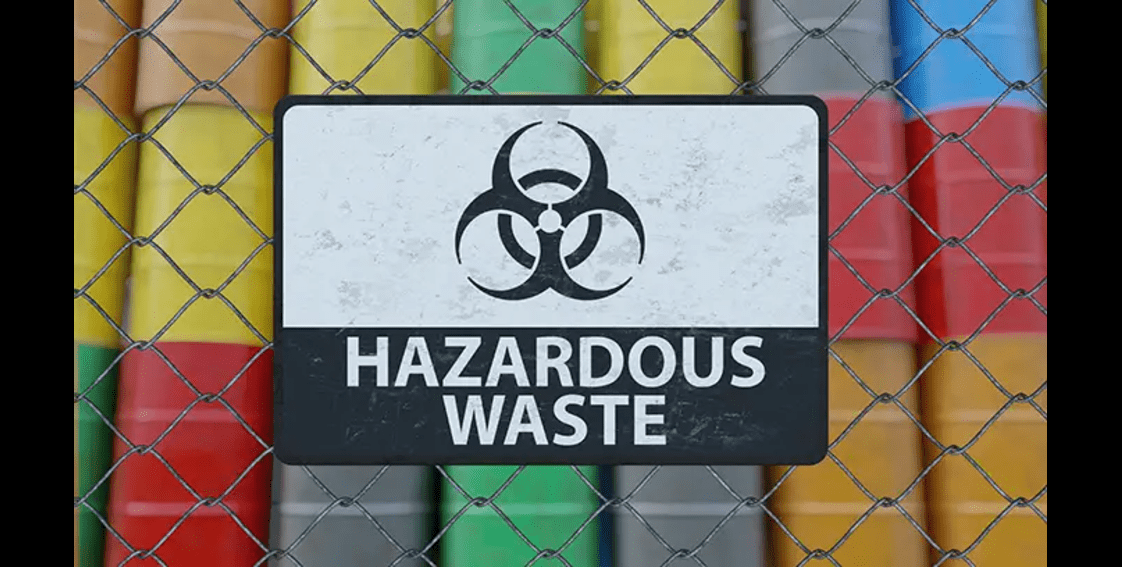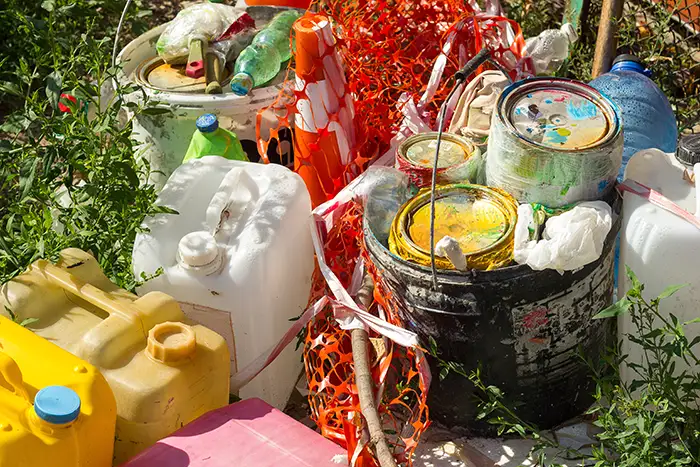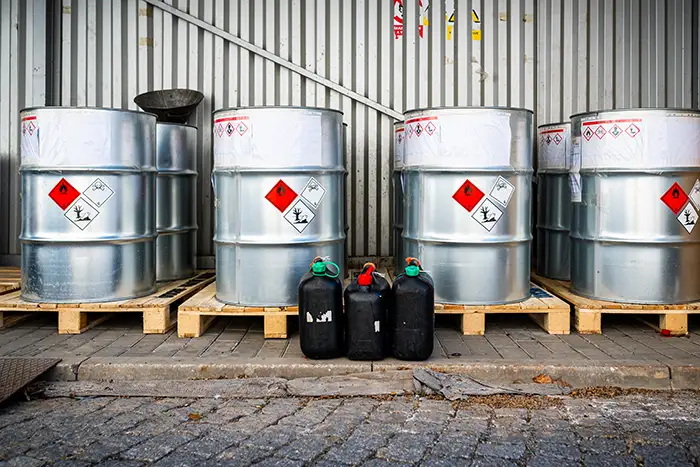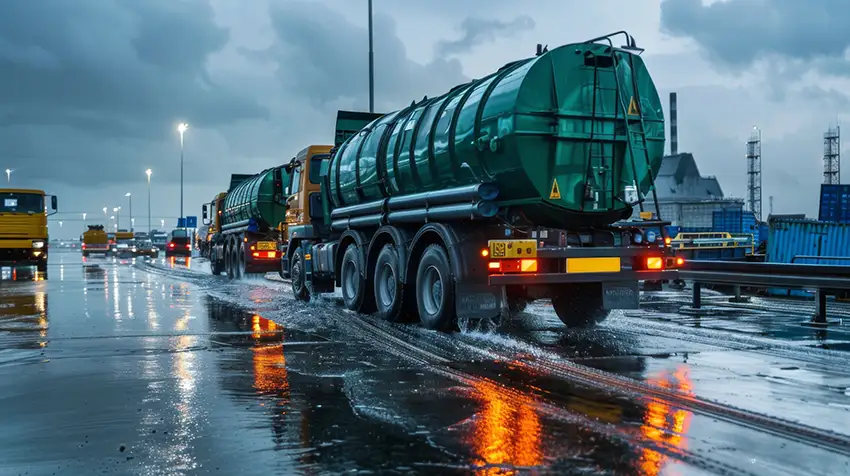
Disposing of Hazardous Waste
- Types of Commercial Hazardous Waste
- Transportation & Handling
- Disposal Methods
- Professional Hazardous Waste Disposal Assistance
Hazardous waste, as defined by the EPA, is any waste materials that pose substantial or potential threats to public health or the environment. These substances include materials that are ignitable, corrosive, reactive, or toxic.
Improper handling and disposal of hazardous waste can have severe consequences, including on-site injuries or deaths, environmental contamination, and significant legal penalties.
To combat these risks, the EPA developed a Cradle-to-Grave regulatory program to ensure hazardous waste is managed safely from creation to disposal. The program provides a regulatory framework that oversees the entire lifecycle of hazardous waste, from the moment it’s generated (the cradle) to its ultimate disposal (the grave).
One of the most important aspects of the Cradle-to-Grave program is understanding how hazardous waste is categorized.
Types of Commercial Hazardous Waste
Listed Wastes
The EPA has four distinct hazardous waste lists:
- F-List (Non-Specific Source Wastes): These wastes come from common manufacturing and industrial processes. Examples include spent halogenated solvents and wastewater treatment sludges.
- K-List (Source-Specific Wastes): This category includes wastes from specific industries, such as petroleum refining or pesticide manufacturing. These wastes are unique to certain processes and include sludges, spent catalysts, and distillation residues.
- P-List (Acutely Hazardous Waste): This category includes discarded commercial chemical products that are acutely hazardous, even in small quantities. They pose significant health risks and include unused chemicals, like certain pesticides and pharmaceutical compounds.
- U-List (Toxic Wastes): Similar to the P-List, the U-List includes discarded commercial chemical products that are hazardous but not as acutely toxic as those on the P-List.
Characteristic Waste
Another way the EPA defines waste is by the characteristics that make it hazardous. The four primary characteristics are:
- Ignitability: Wastes that easily catch fire, such as solvents and fuels. These materials have flashpoints below 140 degrees Fahrenheit and can pose fire hazards during handling and disposal.
- Corrosivity: Wastes that can corrode metals or have extreme pH levels.
- Reactivity: Wastes that are unstable under normal conditions and can cause explosions, toxic fumes, or violent reactions. Examples of reactive waste include certain cyanides and sulfides.
- Toxicity: Wastes that are harmful when ingested or absorbed, like lead and mercury.
Universal Waste
Universal waste includes widely produced hazardous items that pose a lower risk than other categories and are, therefore, subject to less stringent regulations.
There are four main types of universal waste:
- Batteries, including nickel-cadmium and lead-acid
- Pesticides
- Mercury-containing equipment like thermostats
- Fluorescent bulbs and other lighting that contain mercury or lead
Mixed Waste

Mixed waste contains both radioactive and hazardous waste components. Disposing of this type of waste can be challenging because the EPA and the Nuclear Regulatory Commission have their own regulations.
Examples of mixed waste include certain laboratory chemicals, medical waste, and contaminated protective gear.
Storage

- Listed wastes must be stored in leak-proof containers. These containers must be properly labeled to identify the contained waste and its associated hazards. Storage areas should have secondary containment systems and be inspected regularly.
- Characteristic wastes must also be secured in leak-proof containers and properly labeled. Regulations vary based on the material’s characteristics.
- Ignitable wastes must be stored in flame-resistant containers and kept away from ignition sources like open flames, sparks, or static discharge. Storage areas should be properly ventilated.
- Reactive wastes must be stored away from materials or conditions that could trigger dangerous reactions. The storage rooms must maintain stable temperatures and feature regularly maintained gas detectors, emergency shutoff systems, and other safety equipment.
- Toxic wastes must be secured in leak-proof containers in areas with impermeable flooring to prevent leaching. Storage areas should be regularly monitored for leaks and other signs of contamination.
- Corrosive materials must be sealed in corrosion-resistant containers, typically made from materials like polyethylene. Secondary containment systems, like spill pallets, should be in place to catch leaks or spills. The containers and containment systems should be regularly inspected for signs of corrosion.
- There isn’t a strict storage requirement for universal waste. The only requirement is to ensure the waste is stored in a way that minimizes any risk of breakage or contamination.
- Mixed waste storage containers must be compatible with both hazardous and radioactive components and clearly labeled to indicate the presence of mixed waste. Secondary containment is required to prevent leaks and spills. Storage areas should have radiation monitoring devices to ensure exposure levels remain within safe limits. Mixed waste should also be stored away from regular waste to prevent cross-contamination and should only be accessible by authorized individuals trained in mixed waste handling.
Transportation & Handling

Listed, characteristic, and mixed waste types all have specific regulations pertaining to transportation and handling. Universal waste has some requirements, but they are less stringent and only require proper container labeling and safe handling practices to prevent spills.
Listed Waste
- Use the EPA’s Uniform Hazardous Waste Manifest to track waste from the point of origin to the disposal facility.
- Ensure all containers are labeled with the waste’s identity and hazards.
- Use transporters with EPA identification numbers.
- Only have trained personnel handle the waste.
- Have spill response equipment and procedures in place.
Characteristic Waste
- Ensure wastes are compatible with their containers and transport vehicles to prevent reactions.
- Clearly label containers with the appropriate hazard symbols and descriptions.
- Segregate different types of characteristic wastes to prevent dangerous interactions.
- Use appropriate PPE to protect handles from exposure.
Mixed Waste
- Handle mixed waste separately from other wastes to prevent cross-contamination.
- Ensure handlers have specialized training in both hazardous and radioactive waste management.
- Ensure handlers have specialized training in both hazardous and radioactive waste management.
- Use transporters licensed to handle both hazardous and radioactive materials.
- Maintain comprehensive documentation, including the Uniform Hazardous Waste Manifest and additional NRC-required documentation.
- Comply with both EPA and NRC regulations, including 40 CFR Part 263 for hazardous waste transport and 10 CFR Part 71 for radioactive material transport.
Disposal Methods
There are several disposal methods that can be used based on the type of hazardous material.
Shredding
Shredding is often the first step in a disposal process because it reduces the size and volume of waste materials, making them easier and less expensive to handle and process.
This pre-process is only applicable for solid industrial waste like contaminated clothing, gloves, and equipment, electronic waste, and non-infectious medical waste.
Chemical Treatments
Chemical treatments alter the hazardous properties of waste, making it safer for disposal or further processing. Neutralization, oxidation, reduction, and precipitation are the four primary treatment processes that are used.
- Neutralization: Involves adding an acid or base to neutralize the pH of waste. It is commonly used for acidic or alkaline wastes, like industrial acids or caustic soda.
- Oxidation: In this treatment, oxidizing agents are used to convert hazardous chemicals into less harmful substances. It is often used for organic wastes, such as those containing phenols, cyanides, or sulfides.
- Reduction: This method uses reducing agents to convert hazardous substances into less toxic forms. It’s suitable for treating waste containing heavy metals like chromium or mercury.
- Precipitation: This last method involves adding chemicals to waste to form solid particles (called precipitates) that can be removed via filtration. Precipitation is commonly used for wastewater treatment to remove heavy metals and other contaminants.
Physical Treatments
Physical treatments help reduce the volume, toxicity, and mobility of hazardous waste. There are three common methods: filtration, distillation, and evaporation:
- Filtration: Involves passing waste through a porous material (like a wastewater screen) to separate solids materials from liquids. Filtration is most commonly used for treating wastewater and removing suspended solids, such as debris and sediment, from industrial processes.
- Distillation: Involves heating liquid waste to create vapor, then condensing it back into liquid form to separate components based on boiling points. Distillation effectively separates solvents and other volatile organic compounds from mixed waste streams.
- Evaporation: Involves converting liquid waste into vapor to reduce its volume, leaving behind solid or concentrated residues. It’s commonly used for treating aqueous waste streams, like industrial wastewater and leachate, to concentrate contaminants for further treatment or disposal.
Biological Treatment
Biological treatments, like bioremediation and composting, are natural processes that degrade or transform hazardous waste. They are primarily used to treat organic waste.
- Bioremediation: Uses microorganisms to break down hazardous substances into less harmful components. Bioremediation is commonly used for soil and groundwater contaminated with organic pollutants like petroleum hydrocarbons, solvents, and pesticides.
- Composting: Involves the anaerobic decomposition of organic waste by microorganisms to create a stabilized product that can be safely used as a soil conditioner. It’s only used for biodegradable organic wastes, such as agricultural waste, food scraps, and certain industrial by-products.
Material Recovery
In some situations, materials can be recovered from hazardous wastes and potentially reused. These include:
- Precious and heavy metals from electronic waste, batteries, and industrial sludge
- Used solvents from industrial processes
- Certain acids and bases
- Contaminated plastics
Incineration
Incineration can help minimize environmental impact and reduce the potential for harmful emissions. However, not all hazardous waste can be incinerated. Waste that’s commonly incinerated includes organic waste solvents, infectious and non-infectious medical waste, hazardous chemicals from labs and facilities that are difficult to neutralize or recover, and contaminated materials like soil, sludge, and debris contaminated with hazardous organic compounds.
Deep Well Injection
In some situations, liquid hazardous wastes, such as industrial by-products, wastewater, and chemical waste that cannot be treated by other means, are injected into porous rock formations isolated from groundwater supplies.
Deep well injection ensures long-term containment and is often the more economical option when dealing with large quantities of liquid waste.
Stabilization & Solidification
Stabilization and solidification are used to convert hazardous waste into a more stable, less mobile form.
Stabilization involves adding reagents to hazardous waste to reduce its solubility and toxicity. It is often used for heavy metals and other toxic substances.
Solidification involves mixing hazardous waste with binding agents to form a solid mass. This method is suitable for sludge, ash, and other semi-solid wastes.
Encapsulation
Encapsulation is only used for radioactive waste, industrial by-products, contaminated soils, and other waste that will remain hazardous over an extended period. The process involves enclosing hazardous waste into a solid material to prevent the release of contaminants into the environment.
Landfills

Lastly, if no other disposal method is viable for certain solid and semi-solid wastes, they will be transported to a specialized hazardous waste landfill. These specialized landfills have multiple layers of synthetic and clay liners to prevent leachate from escaping into the ground, leachate collecting systems, capping systems to prevent water infiltration, and continuous environmental monitoring to detect potential leaks.
Landfills are generally more cost-effective when dealing with large volumes of stable and non-reactive hazardous waste.
Get Professional Hazardous Waste Disposal Assistance
Having a hazardous waste disposal program in place will help you prevent injuries and fatalities and reduce your environmental impact.
If you need help creating a program or removing hazardous materials on-site, contact Archview Services. We offer comprehensive environmental remediation services, including specialized hazardous material removals and on-site audits and assessments.
Please contact us today to schedule a consultation, or visit our blog for more safety resources.
